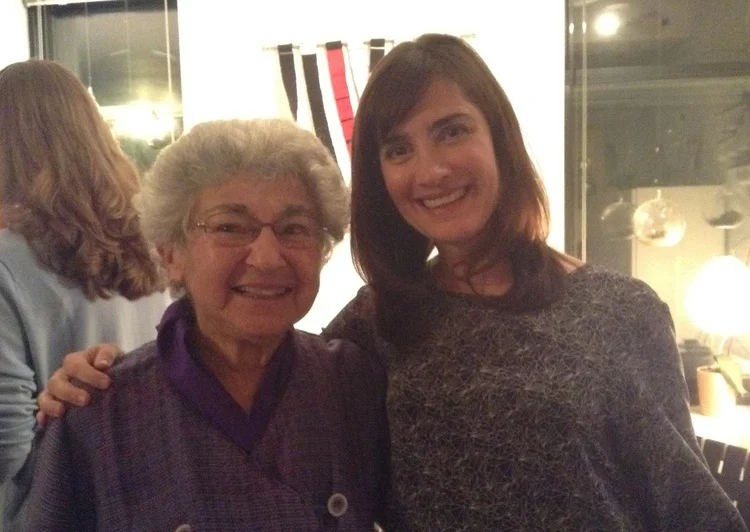We have had the good fortune of living with a pair of three-dimensional woven wall hangings by the artist Lenore Kantor Tetkowski for the Spring season. The pieces -- Boxes with a Twist (28 X 8 in, 2010) and Four Turning Strips (25 X 24 in, 2009), both double weave pick-up, perle cotton -- are powerful examples of Lenore’s lifetime devotion to the art and craft of weaving. And April's opening was a welcome chance to talk with Lee about technique, the tactile pleasure in fibers, the deliberative process of warping the loom and mapping out an artistic journey, and the metaphorical -- even metaphysical -- richness of this ancient art form.
The evening was especially poignant because Lee is the mother of artist (and our dear friend) Neil Tetkowski, whose ceramic piece Flip Phone was our second featured artwork a year earlier. Moreover, Neil is the director of galleries at Kean University, formerly Newark State Teachers College, where Lee was a student in the early 1940s. It was there that she met Neil’s father, Clem, and first learned to weave.
Neil introduced his mother, now 92, as a natural storyteller, a beloved teacher (indeed, one of her former high-school art students, a childhood friend of Neil’s, was in attendance), and a still restless artist in whose work he only recently began to recognize traces of Bauhaus influence.
As we reviewed images of her work, which had been the subject of a solo show at Kean’s Nancy Dryfoos Gallery in 2012, Lee talked about her interest in mathematics and its essential role in weaving, from calculating fiber lengths to the process of warping to the geometry of the patterns she weaves. While many of her works include representational imagery, including the birds and trees that evoke her love of the natural world, Lee’s abstract pieces, including the two on display, reflect her preoccupation with technique and experimentation.
Boxes with a Twist and Four Turning Strips are examples of Lee’s fascination with double weave, which has a second set of warp and weft that enables her to produce double-sided textiles and create more complex, three-dimensional patterns. Commenting on Boxes with a Twist, one guest noted that the twisted strands at the bottom, one of which revealed a solid red weave on the reverse side, reminded her of the double-helix DNA molecule (with the red strand as a hidden recessive trait). We began to discuss the dimensionality of weaving, the intersecting planes of space and time, and how the emergence of textiles in early cultures signaled the dawn of abstract thought and the ability to envision and pursue an indeterminate future. Lee particularly liked the notion of weaving as an expression and representation of time, and noted that for all of the technological advances that have made some aspects more efficient, weaving techniques are essentially the same as they were thousands of years ago.








